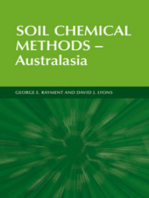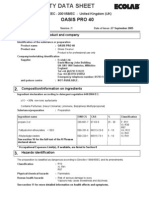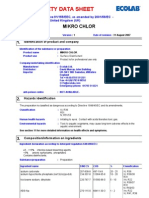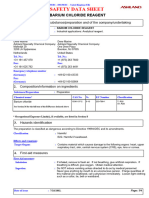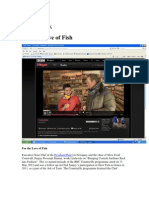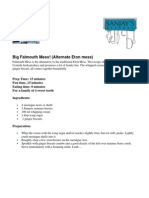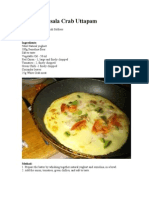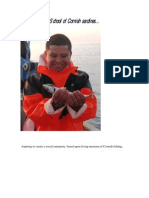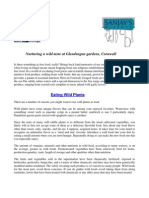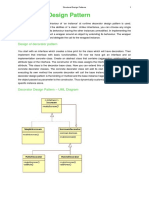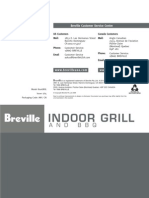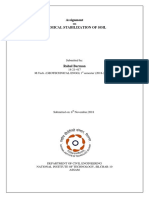Mould Ex
Mould Ex
Uploaded by
Prosenjit76Copyright:
Available Formats
Mould Ex
Mould Ex
Uploaded by
Prosenjit76Original Title
Copyright
Available Formats
Share this document
Did you find this document useful?
Is this content inappropriate?
Copyright:
Available Formats
Mould Ex
Mould Ex
Uploaded by
Prosenjit76Copyright:
Available Formats
SAFETY DATA SHEET
Conforms to EU Directive 91/155/EEC, as amended by 2001/58/EC -
United Kingdom (UK)
Mould-Ex
Code : 111800E Version : 1 Date of revision : 1 August 2007
1. Identification of product and company
Identification of the substance or preparation
Product name : Mould-Ex
Product use : Special detergent
Product is for professional use only
Company/undertaking identification
Manufacturer/ : Ecolab Ltd.
Distributor/ David Murray John Building
Importer UK-SN1 1NH Swindon, Wiltshire
England
Tel +44 (0)1793 511221
Fax +44 (0)1793 618552
CCS@ecolab.com
Emergency phone: 01793 511221
anti-poison centre : NOT AVAILABLE.
2. Hazards identification
The preparation is classified as dangerous according to Directive 1999/45/EC and its amendments.
Classification : C; R34
R31
Human health hazards : Causes burns. Contact with acids liberates toxic gas.
See section 11 for more detailed information on health effects and symptoms.
3. Composition/information on ingredients
Ingredient declaration according to detergent regulation 648/2004/EC:
≥5 - <15% chlorine-based bleaching agents
<5% anionic surfactants, non-ionic surfactants
Contains Perfumes: (Limonene)
Substance/preparation : Preparation
Ingredient name EINECS CAS % Classification
Sodium hypochlorite 231-668-3 7681-52-9 5 - 10 C; R34
R31
N; R50
potassium hydroxide 215-181-3 1310-58-3 1-2 Xn; R22
C; R35
Alkylamineoxides 263-016-9 61788-90-7 1-2 Xi; R41, R38
N; R50
See section 16 for the full text of the R-phrases
declared above
Occupational exposure limits, if available, are listed in section 8.
Date of issue : 1 August 2007 Page: 1/5
Mould-Ex
4. First-aid measures
First-aid measures
Inhalation : If inhaled, remove to fresh air. In all cases of doubt, or when symptoms
persist, seek medical attention.
Ingestion : Do not induce vomiting unless directed to do so by medical personnel. If
swallowed, rinse mouth with water (only if the person is conscious).
Skin contact : In case of contact, immediately flush skin with plenty of water for at least 15
minutes while removing contaminated clothing and shoes. Get medical
attention immediately.
Eye contact : In case of contact with eyes, rinse immediately with plenty of water. Get
medical attention immediately.
Specific treatments : Not available.
See section 11 for more detailed information on health effects and symptoms.
5. Fire-fighting measures
Extinguishing media : In case of fire, use water spray (fog), foam, dry chemical, or CO2.
Special protective equipment : Fire-fighters should wear proper protective equipment.
for fire-fighters
6. Accidental release measures
Personal precautions : Large spill and leak Immediately contact safety personnel.
Environmental precautions and : Avoid dispersal of spilt material and runoff and contact with soil, waterways,
clean-up methods drains and sewers.
Small spill: Rinse with plenty of running water. For large spills, dyke spilt
material or otherwise contain material to ensure runoff does not reach a
waterway. Place spilt material in an appropriate container for disposal.
Note: see section 8 for personal protective equipment and section 13 for waste disposal.
7. Handling and storage
Handling : Do not get in eyes or on skin or clothing. Do not ingest. Keep away from
acids. After handling, always wash hands thoroughly with soap and water.
Storage : Keep container tightly closed. Keep container in a cool, well-ventilated area.
Do not store above the following temperature: 25°C
Packaging materials
Recommended : Use original container.
8. Exposure controls/personal protection
Ingredient name Occupational exposure limits
potassium hydroxide EH40-WEL (United Kingdom (UK), 9/2006).
WEL 15 min limit: 2 mg/m³ 15 minute(s).
Exposure controls
Respiratory protection : A respirator is not needed under normal and intended conditions of product
(EN 143, 141) use.
Hand protection : 1 - 4 hours: butyl rubber, nitrile rubber
(EN 374)
Eye protection : Goggles, face shield, or other full-face protection.
(EN 166)
Skin protection : safety apron Suitable protective footwear.
(EN 467)
Date of issue : 1 August 2007 Page: 2/5
Mould-Ex
9. Physical and chemical properties
General information
Appearance
Physical state : Liquid.
Colour : Yellow.
Odour : chlorine
Important health, safety and environmental information
pH : 13 (100%)
Boiling point : Not available.
Melting point : Not available.
Flash point : > 100°C
Flammability (solid, gas) : Not applicable.
Explosive properties : Not applicable.
Explosion limits : Not applicable.
Oxidising properties : Not available.
Vapour pressure : Not applicable.
Relative density : 1.13 g/cm3 (20 °C)
Solubility : Easily soluble in cold water.
Octanol/water partition : Not applicable.
coefficient
Viscosity : Not available.
Vapour density : Not available.
Evaporation rate (butyl : Not applicable.
acetate = 1)
10. Stability and reactivity
Stability : Stable under normal conditions.
Materials to avoid : Extremely reactive or incompatible with the following materials: acids.
Do not mix with other products.
11. Toxicological information
Potential acute health effects
Inhalation : Harmful by inhalation.
Ingestion : May cause burns to mouth, throat and stomach.
Skin contact : Corrosive to the skin.
Eye contact : Corrosive to eyes.
Carcinogenicity : No known significant effects or critical hazards.
Reproductive toxicity : No known significant effects or critical hazards.
12. Ecological information
Ecotoxicity
The product is not subject to ecological classification according to directive 1999/45/EC.
Persistence and degradability
The surfactants contained in the product are biodegradable according to the requirements of the detergent
regulation 648/2004/EC
Date of issue : 1 August 2007 Page: 3/5
Mould-Ex
13. Disposal considerations
Methods of disposal : Waste must be disposed of according to applicable regulations. Use as much
of the contents as possible, according to instructions. Can be added to general
waste collection after completely emptying. Use packages for recycling only
when totally empty.
European waste catalogue : 200129*
(EWC)
14. Transport information
International transport regulations
Regulatory UN number Proper shipping name Class Packing Label
information group
ADR/RID Class UN1791 HYPOCHLORITE SOLUTION 8 III 8
ADN Class UN1791 HYPOCHLORITE SOLUTION 8 III 8
IMDG Class UN1791 HYPOCHLORITE SOLUTION 8 III 8
Follow special pack instructions for air transport.
15. Regulatory information
EU regulations
Hazard symbol/symbols :
Corrosive
Contains : sodium hypochlorite
potassium hydroxide
Risk phrases : R34- Causes burns.
R31- Contact with acids liberates toxic gas.
Safety phrases : S2- Keep out of the reach of children.
S7- Keep container tightly closed.
S26- In case of contact with eyes, rinse immediately with plenty of water and
seek medical advice.
S36/37/39- Wear suitable protective clothing, gloves and eye/face protection.
S45- In case of accident or if you feel unwell, seek medical advice immediately
(show the label where possible).
National regulations
The Chemicals (Hazard Information and Packaging for Supply) Regulations.
The Control of Substances Hazardous to Health Regulations.
Health and Safety at Work Act.
16. Other information
Full text of R-phrases referred : R22- Harmful if swallowed.
to in sections 2 and 3 - United R34- Causes burns.
Kingdom (UK) R35- Causes severe burns.
R41- Risk of serious damage to eyes.
R38- Irritating to skin.
R31- Contact with acids liberates toxic gas.
R50- Very toxic to aquatic organisms.
History
Date of issue : 1 August 2007 Page: 4/5
Mould-Ex
Date of printing : 2 August 2007
Date of revision : 1 August 2007
Version : 1
Prepared by : Ecolab Regulatory Department Europe
Notice to reader
The above information is believed to be correct with respect to the formula used to manufacture the
product in the country of origin. As data, standards, and regulations change, and conditions of use and
handling are beyond our control, NO WARRANTY, EXPRESS OR IMPLIED, IS MADE AS TO THE
COMPLETENESS OR CONTINUING ACCURACY OF THIS INFORMATION.
Version 1 Page: 5/5
You might also like
- AFC Coaches Log BookDocument10 pagesAFC Coaches Log BookRais Fakhri Bin Azha100% (3)
- Xinnong Cheng - Chinese Acupuncture and Moxibustion 1Document282 pagesXinnong Cheng - Chinese Acupuncture and Moxibustion 1Abrar Abizar100% (2)
- Manual OltDocument136 pagesManual Oltcarlos juniorNo ratings yet
- Savol Beerline CleanerDocument5 pagesSavol Beerline CleanerProsenjit76No ratings yet
- Oasis Pro 20Document5 pagesOasis Pro 20Prosenjit76No ratings yet
- Savol Cabinet GlasswashDocument5 pagesSavol Cabinet GlasswashProsenjit76No ratings yet
- Lime A Way ExtraDocument5 pagesLime A Way ExtraProsenjit76No ratings yet
- MR ShifterDocument5 pagesMR ShifterProsenjit76No ratings yet
- Grease Strip PlusDocument5 pagesGrease Strip PlusProsenjit760% (1)
- Oasis Pro 40Document5 pagesOasis Pro 40Prosenjit76No ratings yet
- Oasis Pro 61Document4 pagesOasis Pro 61Prosenjit76No ratings yet
- Sapur BDocument5 pagesSapur BProsenjit76No ratings yet
- P3-Topax 36Document5 pagesP3-Topax 36imranshaik3000No ratings yet
- Into Fresh: Conforms To EU Directive 91/155/EEC, As Amended by 2001/58/EC - United Kingdom (UK)Document4 pagesInto Fresh: Conforms To EU Directive 91/155/EEC, As Amended by 2001/58/EC - United Kingdom (UK)Prosenjit76No ratings yet
- Mikro ChlorDocument5 pagesMikro ChlorProsenjit76No ratings yet
- Dip-It PlusDocument5 pagesDip-It PlusProsenjit76No ratings yet
- Lime A Way SpecialDocument4 pagesLime A Way SpecialProsenjit76No ratings yet
- Savol Cabinet RinseaidDocument4 pagesSavol Cabinet RinseaidProsenjit76No ratings yet
- 5482 3a11c5kubDocument4 pages5482 3a11c5kubNandar Min HtetNo ratings yet
- 0041 Q6boc5kubDocument5 pages0041 Q6boc5kubNandar Min HtetNo ratings yet
- Klorin EnglishDocument4 pagesKlorin EnglishZika Cahyati PutriNo ratings yet
- 1273 20bgc5kubDocument5 pages1273 20bgc5kubNandar Min HtetNo ratings yet
- 0045 Lfu5c5kubDocument5 pages0045 Lfu5c5kubNandar Min HtetNo ratings yet
- AGK-100 Phosphate AmpoulesDocument5 pagesAGK-100 Phosphate AmpoulesSENTHIL KUMARNo ratings yet
- 2bhlc5kubDocument4 pages2bhlc5kubNandar Min HtetNo ratings yet
- 1277 Upu8c5kubDocument4 pages1277 Upu8c5kubNandar Min HtetNo ratings yet
- 0544 E1ifc5kubDocument5 pages0544 E1ifc5kubNandar Min HtetNo ratings yet
- Hhe4c5kubDocument10 pagesHhe4c5kubNandar Min HtetNo ratings yet
- 1732 0btnc5kubDocument4 pages1732 0btnc5kubNandar Min HtetNo ratings yet
- 1214 Lfp0c5kubDocument4 pages1214 Lfp0c5kubNandar Min HtetNo ratings yet
- 2973 - Britannia AFFF COSHH SheetDocument6 pages2973 - Britannia AFFF COSHH SheetPrasad BangaruNo ratings yet
- 7266 Fq1hc5kubDocument5 pages7266 Fq1hc5kubNandar Min HtetNo ratings yet
- 0830 Bpvac5kubDocument5 pages0830 Bpvac5kubNandar Min HtetNo ratings yet
- 0024 Hvnjc5kubDocument4 pages0024 Hvnjc5kubNandar Min HtetNo ratings yet
- 14-MSDS (SodiumChlorite)Document8 pages14-MSDS (SodiumChlorite)Khizar NaqviNo ratings yet
- Sirafan SpeedDocument5 pagesSirafan SpeedProsenjit76No ratings yet
- MSDS Fffp-English1Document5 pagesMSDS Fffp-English1NasrulNo ratings yet
- 0008 R61tc5kubDocument4 pages0008 R61tc5kubNandar Min HtetNo ratings yet
- 0011 1550c5kubDocument5 pages0011 1550c5kubNandar Min HtetNo ratings yet
- 99p9c5kubDocument5 pages99p9c5kubNandar Min HtetNo ratings yet
- 1702 Tq0ac5kubDocument4 pages1702 Tq0ac5kubNandar Min HtetNo ratings yet
- 1274 N48uc5kubDocument6 pages1274 N48uc5kubNandar Min HtetNo ratings yet
- 0651 Lb6gc5kubDocument5 pages0651 Lb6gc5kubNandar Min HtetNo ratings yet
- 8809872588830Document5 pages8809872588830Anurag JainNo ratings yet
- 1t9bc5kubDocument4 pages1t9bc5kubNandar Min HtetNo ratings yet
- 1280 Bktpc5kubDocument5 pages1280 Bktpc5kubNandar Min HtetNo ratings yet
- 1717 43eoc5kubDocument6 pages1717 43eoc5kubNandar Min HtetNo ratings yet
- Fe-1a Acidizing Composition - 3Document6 pagesFe-1a Acidizing Composition - 3RG TNo ratings yet
- 4608 Vpmmc5kubDocument5 pages4608 Vpmmc5kubNandar Min HtetNo ratings yet
- 0065 Behqc5kubDocument4 pages0065 Behqc5kubNandar Min HtetNo ratings yet
- 1725 Hnu5c5kubDocument5 pages1725 Hnu5c5kubNandar Min HtetNo ratings yet
- Fosroc Nitoflor FC 130 and Nitoflor FC140 BaseDocument8 pagesFosroc Nitoflor FC 130 and Nitoflor FC140 Basearaka44No ratings yet
- Gfebc5kubDocument4 pagesGfebc5kubNandar Min HtetNo ratings yet
- EC Safety Data Sheet: 1. Name of Product, Characterization and Company NameDocument3 pagesEC Safety Data Sheet: 1. Name of Product, Characterization and Company NamemitramgopalNo ratings yet
- 1743 Tdjsc5kubDocument5 pages1743 Tdjsc5kubNandar Min HtetNo ratings yet
- 1272 0s3cc5kubDocument5 pages1272 0s3cc5kubNandar Min HtetNo ratings yet
- Safety Data Sheet: 1. Material IdentificationDocument5 pagesSafety Data Sheet: 1. Material IdentificationMichele BovomiNo ratings yet
- 77001-00001 Reach PDFDocument5 pages77001-00001 Reach PDFHector GaracheNo ratings yet
- Goodrich Shine Master Prep MSDSDocument5 pagesGoodrich Shine Master Prep MSDSSkySupplyUSANo ratings yet
- 0089 Ei6uc5kubDocument5 pages0089 Ei6uc5kubNandar Min HtetNo ratings yet
- Ec 54NFDocument4 pagesEc 54NFtitus gurningNo ratings yet
- Floor Shine and Hardener MSDSDocument6 pagesFloor Shine and Hardener MSDSjas020No ratings yet
- Mrs Bawcocks Morgy Bites Dog Fish HotdogDocument1 pageMrs Bawcocks Morgy Bites Dog Fish HotdogProsenjit76No ratings yet
- Cream of Cornish Bycatch SoupDocument1 pageCream of Cornish Bycatch SoupProsenjit76No ratings yet
- Upon Visiting Mother Earth (#Terramadre) 2012Document2 pagesUpon Visiting Mother Earth (#Terramadre) 2012Prosenjit76No ratings yet
- How To Fall in Love With Cornish Sardines Once AgainDocument3 pagesHow To Fall in Love With Cornish Sardines Once AgainProsenjit76100% (1)
- Hashed Pigs in BlanketsDocument1 pageHashed Pigs in BlanketsProsenjit76No ratings yet
- Teetari An Indian Game RecipeDocument2 pagesTeetari An Indian Game RecipeProsenjit76No ratings yet
- Peruvian Anchoveta Pilaf As Cooked in TerraMadre 2012Document2 pagesPeruvian Anchoveta Pilaf As Cooked in TerraMadre 2012Prosenjit76No ratings yet
- Cornwall SSE Graduation Booklet 4Document23 pagesCornwall SSE Graduation Booklet 4Prosenjit76No ratings yet
- For The Love of Fish - Slow Food U.K.covers Cornish SardinesDocument2 pagesFor The Love of Fish - Slow Food U.K.covers Cornish SardinesProsenjit76No ratings yet
- FalmouthMess .Alternate Eton MessDocument1 pageFalmouthMess .Alternate Eton MessProsenjit76No ratings yet
- Eclade of Tregothnan Tea Smoked Cornish MusselsDocument2 pagesEclade of Tregothnan Tea Smoked Cornish MusselsProsenjit76No ratings yet
- Masala Crab UttapamDocument2 pagesMasala Crab UttapamProsenjit76No ratings yet
- School of Cornish SardinesDocument1 pageSchool of Cornish SardinesProsenjit76No ratings yet
- Sanjay's Mixed NutsDocument2 pagesSanjay's Mixed NutsProsenjit76No ratings yet
- Foraged Foods in Cornwall - Recipes and Ramblings at Glendurgan GardensDocument4 pagesForaged Foods in Cornwall - Recipes and Ramblings at Glendurgan GardensProsenjit76No ratings yet
- 42pf9966 10 PssDocument3 pages42pf9966 10 PssВеселовський ПетроNo ratings yet
- Image StenographyDocument77 pagesImage StenographyRohan lokhandeNo ratings yet
- Crowd Management TextDocument17 pagesCrowd Management TextGeorge Trowbridge100% (1)
- Jurnal Persalinan NormalDocument8 pagesJurnal Persalinan NormalIannetNo ratings yet
- Science Curriculum in The Primary School 2018Document2 pagesScience Curriculum in The Primary School 2018MsHong BgsNo ratings yet
- Structural Design PatternDocument34 pagesStructural Design PatternAkula SandeepNo ratings yet
- Alkyl Halides and Amines - PreMedDocument27 pagesAlkyl Halides and Amines - PreMedShahzadNo ratings yet
- Breville 800GRXL ManualDocument96 pagesBreville 800GRXL ManualBrevilleNo ratings yet
- rESEARCJ REVIEWRDocument15 pagesrESEARCJ REVIEWRfelize padllaNo ratings yet
- Aviation English CourseDocument1 pageAviation English CourseStoyko LyutskanovNo ratings yet
- Nursing Care Plan: Prepared By: Janida AsjadaDocument23 pagesNursing Care Plan: Prepared By: Janida AsjadaRej PanganibanNo ratings yet
- Bài tập Anh 11 HKII (Trắc nghiệm)Document48 pagesBài tập Anh 11 HKII (Trắc nghiệm)Cường NguyễnNo ratings yet
- Chemical Stabilization of SoilDocument6 pagesChemical Stabilization of SoilRahul BarmanNo ratings yet
- ACCOUNTING TUTORIALS (Income Statement)Document1 pageACCOUNTING TUTORIALS (Income Statement)Rizza Christine Thereza UsbalNo ratings yet
- Product Manual BT700D: Bloomfoss Pte LTDDocument5 pagesProduct Manual BT700D: Bloomfoss Pte LTDStathis MoumousisNo ratings yet
- The Evolution of Airbus Helicopters, IncDocument4 pagesThe Evolution of Airbus Helicopters, Incluc-Jean NiergraNo ratings yet
- Hospice Bulletin AprilFinalDocument12 pagesHospice Bulletin AprilFinalmalaysianhospicecouncil6240100% (3)
- Sally Carline - Lesson Plans For Creative Dance - Connecting With Literature, Arts, and Music-Human Kinetics (2011)Document200 pagesSally Carline - Lesson Plans For Creative Dance - Connecting With Literature, Arts, and Music-Human Kinetics (2011)venkataramanaNo ratings yet
- 7 C's of CommunicationDocument9 pages7 C's of CommunicationZain MirNo ratings yet
- Hindu ScripturesDocument32 pagesHindu ScripturesRaaj Gupta100% (2)
- Fixed Free Fixed Free Plate Natural Frequency AnalysisDocument7 pagesFixed Free Fixed Free Plate Natural Frequency AnalysisJan ScarNo ratings yet
- Consumer Protection Rights in BangladeshDocument34 pagesConsumer Protection Rights in Bangladeshmd.jewel ranaNo ratings yet
- 5 Powerful Lessons in The Life of Cain and Abel 1Document5 pages5 Powerful Lessons in The Life of Cain and Abel 1Mercy Balagosa Palmares100% (1)
- Multiple Choice Questions (MCQ) Topic Quiz Set 1 Measurements, Materials, Forces and MotionDocument40 pagesMultiple Choice Questions (MCQ) Topic Quiz Set 1 Measurements, Materials, Forces and MotionNaveed BhopaliNo ratings yet
- Xamidea Human ReproductionDocument42 pagesXamidea Human Reproductionkeren spamzNo ratings yet
- Loans and Savings Management System For Bentuco National High School Faculty CooperativeDocument7 pagesLoans and Savings Management System For Bentuco National High School Faculty CooperativeInternational Journal of Innovative Science and Research TechnologyNo ratings yet
- Madhav Institute of Technology & Science, Gwalior: Examination Admit Card (Eac)Document1 pageMadhav Institute of Technology & Science, Gwalior: Examination Admit Card (Eac)Rohan MalakarNo ratings yet


